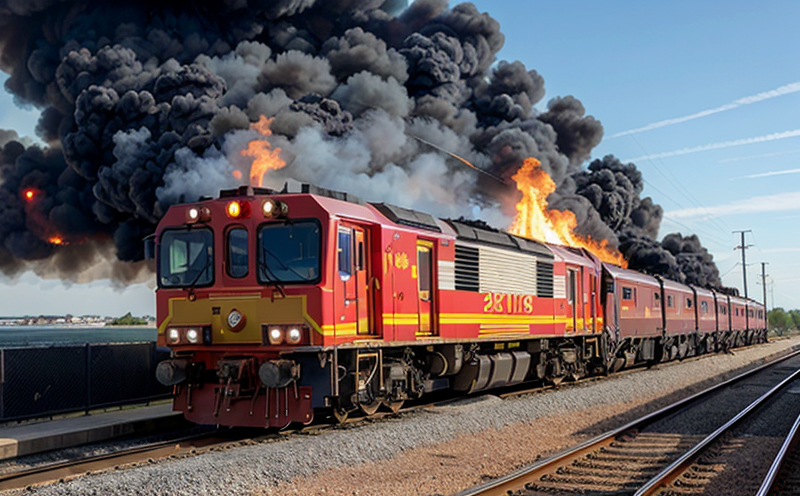Marine & Railway Fire Safety Testing
In the sectors of marine and railway transportation, fire safety is a paramount concern. The maritime environment presents unique challenges due to its expansive nature, high humidity levels, and the presence of various flammable materials. Similarly, railways must contend with the continuous movement of trains through diverse environments, including tunnels, open plains, and urban settings. Fire tests in these sectors are crucial for ensuring that materials used do not contribute to or exacerbate fire risk.
The primary objective is to ensure compliance with international standards such as ISO 16725-3:2019, which specifies the test methods for flammability of materials intended for use in railway vehicles. These tests are designed to simulate real-world conditions that a material might encounter during service. For marine applications, EN 13823:2011 provides guidelines on fire protection and safety in ships.
The testing process involves rigorous procedures aimed at evaluating the flammability of materials under controlled laboratory conditions. This includes both horizontal burning tests (HB) and vertical burning tests (V0, V1, V2). The HB test assesses how quickly a sample ignites when exposed to an external heat source, while the V0, V1, and V2 tests evaluate the flame spread characteristics of materials in a vertical orientation. These tests are essential for ensuring that all components used in these industries meet stringent safety standards.
For marine applications, additional considerations include exposure to saltwater, which can affect material integrity and flammability. Similarly, railway environments must account for extreme temperatures and vibrations encountered during operation. The testing apparatus used includes specialized chambers capable of simulating these conditions accurately. These facilities are equipped with precise temperature control systems, humidity sensors, and state-of-the-art ignition devices.
The acceptance criteria for fire safety tests in marine and railway sectors are stringent and vary depending on the specific application. For instance, materials used in passenger cabins must pass rigorous flammability tests to ensure they do not pose a risk of fire spreading rapidly. The same applies to seating upholstery, carpets, and insulation materials within rail vehicles.
| Parameter | Description |
|---|---|
| Test Method | ISO 16725-3:2019 for railways, EN 13823:2011 for ships |
| Temperature Range | Room temperature to 45°C (for railway tests), up to 65°C (for shipboard materials) |
| Humidity Levels | Relative humidity up to 90% for both sectors |
| Ignition Source | Flame or hot wire (depending on the test method) |
The testing process is critical in ensuring that all materials used in marine and railway environments are safe from fire hazards. By adhering to these stringent standards, manufacturers can ensure their products meet regulatory requirements while also enhancing passenger safety.
Why It Matters
- Reduces the risk of fires in critical transportation sectors.
- Avoids potential disasters that could result from material failure during fire events.
- Ensures compliance with international safety standards for marine and railway transport.
- Promotes a safer working environment for personnel involved in these industries.
The significance of fire safety testing cannot be overstated. In the event of a fire, even minor breaches in material integrity can lead to catastrophic consequences. By conducting thorough tests and ensuring compliance with relevant standards, stakeholders contribute significantly towards maintaining high levels of safety across marine and railway operations.
Customer Impact and Satisfaction
- Enhanced confidence in product performance and reliability.
- Increased trust among customers regarding the quality and safety of products.
- Improved reputation for compliance with international standards.
- Higher customer satisfaction due to reduced risk factors associated with fire hazards.
The impact on customers is profound. By offering services that ensure materials meet stringent fire safety criteria, laboratories provide peace of mind knowing their products are reliable and safe. This not only enhances brand reputation but also fosters long-term relationships built on trust and reliability.
Use Cases and Application Examples
| Material Type | Application Example |
|---|---|
| Foam Insulation | Insulating panels for ship engine rooms and railway vehicle underframes. |
| Upholstery Fabrics | Cab interior seating materials in both marine and railway passenger compartments. |
| Carpeting | Floor coverings for passenger areas of ships and trains. |
The use cases for fire safety testing are extensive. From insulating materials used in ship engine rooms to seating fabrics within railway carriages, these tests ensure that every component is safe under all conditions. The examples provided highlight the critical role played by these tests in enhancing overall safety across various marine and railway applications.





